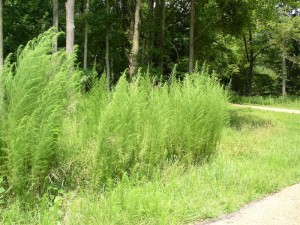Dog Fennel – September Wildflower of the Month
Eupatorium capillifolium. Tall plants with lacy fernlike leaves line roadsides and woodland edges, usually in drifts, in late summer. The leaves are narrow and very finely divided. In early fall from September through November, the tiny daisy-like white flowers are replaced by small red berries. As the fruits age, the seeds develop hairs, like those of dandelions, allowing dispersal by the wind.
An attractive plant, Dog-fennel grows over 6 feet tall, and can provide a dramatic backdrop in the garden or containers. But it’s very aggressive and weedy and crowds out other, more delicate plants. There is sterile cultivar called ‘Elegant Feather’ that has a more benign growth habit and doesn’t produce seed.
Dog-fennel grows on the Coastal Plain from New Jersey to Florida, Texas and Arkansas, and in eastern Virginia counties. It is common in habitats where the soil has been severely disturbed, burned areas, clear-cuts, and various moist to wet locales. The plant spreads both by seeds and rootstocks which come from the main taproot and grow laterally in all directions.
When crushed, the leaves and flowers release an unpleasant odor. The common name refers to the fennel-like odor, which dogs appear to enjoy. Essential oils of Dog-fennel have shown activity as an insecticide and antifungal agent; leaves have been used to repel mosquitoes and juice from the plant extracted to treat bites of reptiles and insects. Livestock usually avoid consuming Dog Fennel since the plant contains liver-damaging alkaloids.
The species name capillifolium is derived from the Latin capill meaning “hair” and folium meaning “leaf,” referring to the thin segments of the leaves.
By Helen Hamilton, past-president of the John Clayton Chapter, VNPS
Photo: Dog-fennel (Eupatorium capillifolium) taken by Helen Hamilton

